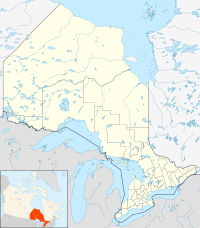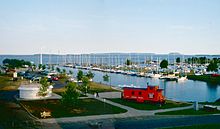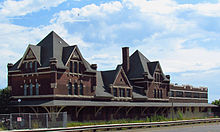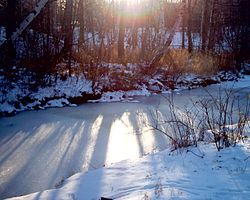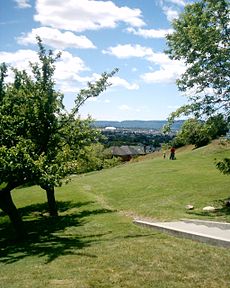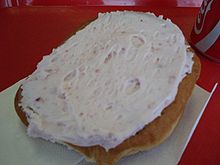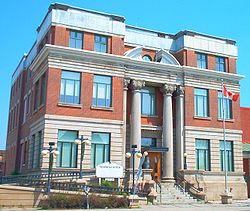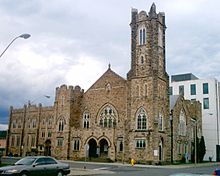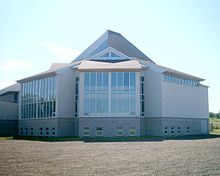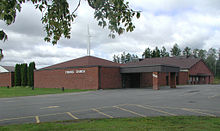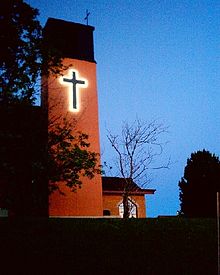- Thunder Bay
-
For other uses, see Thunder Bay (disambiguation).
Thunder Bay — City — Marina Park, and Downtown Thunder Bay North 
Flag
LogoNickname(s): (The) Lakehead; TBay; The Bay Motto: Superior by Nature / The Gateway To The West Location of Thunder Bay in Ontario Coordinates: 48°22′56″N 89°14′46″W / 48.38222°N 89.24611°WCoordinates: 48°22′56″N 89°14′46″W / 48.38222°N 89.24611°W Country  Canada
CanadaProvince  Ontario
OntarioDistrict Thunder Bay District CMA Thunder Bay Settled 1683 as Fort Caministigoyan Amalgamation 1 January 1970 Electoral Districts
Federal
Thunder Bay—Superior North/Thunder Bay—Rainy RiverProvincial Thunder Bay—Superior North/Thunder Bay—Atikokan Government[1][2] – Type Municipal Government – Mayor Keith Hobbs – City manager Tim Commisso[3] – Governing Body Thunder Bay City Council – MPs Bruce Hyer (NDP)
John Rafferty (NDP)– MPPs Michael Gravelle (OLP)
Bill Mauro (OLP)Area[4][5][6] – City 447.5 km2 (172.8 sq mi) – Land 328.5 km2 (126.8 sq mi) – Water 119.0 km2 (45.9 sq mi) 26.6% – Urban 179.7 km2 (69.4 sq mi) – Metro 2,550.4 km2 (984.7 sq mi) Elevation[7] 199 m (653 ft) Population (2006)[4][5] – City 109,140 (Ranked 43rd) – Density 332.3/km2 (860.7/sq mi) – Urban 103,247 (Ranked 29th) – Urban density 574.5/km2 (1,487.9/sq mi) – Metro 122,907 (Ranked 31st) – Metro density 48.2/km2 (124.8/sq mi) – Demonym Thunder Bayer Time zone EST (UTC−5) – Summer (DST) EDT (UTC−4) Postal code FSA P7A to P7G, P7J, P7K Area code(s) 807 NTS Map 052A06 GNBC Code FCWFX Website www.thunderbay.ca Thunder Bay is a city in and the seat of Thunder Bay District, Ontario, Canada. It is the most populous municipality in Northwestern Ontario, and the second most populous in Northern Ontario after Greater Sudbury. The census metropolitan area of Thunder Bay has a population of 122,907, and consists of the city of Thunder Bay, the municipalities of Oliver Paipoonge and Neebing, the townships of Shuniah, Conmee, O'Connor and Gillies and the Fort William First Nation.
European settlement in the region began in the late 17th century with a French fur trading outpost on the banks of the Kaministiquia River.[8] It grew into an important transportation hub with its port forming an important link in the shipping of grain and other products from western Canada through the Great Lakes and the Saint Lawrence Seaway to the east coast. Forestry and manufacturing played important roles in the city's economy. They have declined in recent years, but have been replaced by a "knowledge economy" based on medical research and education. Thunder Bay is the site of the Thunder Bay Regional Research Institute.
The city takes its name from the immense Thunder Bay at the head of Lake Superior, known on 18th-century French maps as Baie du Tonnerre (Bay of Thunder).[8] The city is often referred to as the "Lakehead" or "Canadian Lakehead" because of its location at the end of Great Lakes navigation.[9]
Contents
History
Main articles: Port Arthur, Ontario and Fort William, OntarioBefore 1900
European settlement on Thunder Bay began with two French fur trading posts (1683, 1717) which were subsequently abandoned (see Fort William, Ontario). In 1803 the Montreal-based North West Company established Fort William as its mid-continent entrepôt. The fort thrived until 1821 when the North West Company merged with the Hudson's Bay Company, and Fort William was no longer needed.
By the 1850s, the Province of Canada began to take an interest in its western extremity. Discovery of copper in the Keweenaw Peninsula of Michigan had prompted a national demand for mining locations on the Canadian shores of Lake Superior. In 1849 French-speaking Jesuits established the Mission de l'Immaculée-Conception (Mission of the Immaculate Conception) on the Kaministiquia to evangelize the Ojibwe. The Province of Canada negotiated the Robinson Treaty in 1850 with the Ojibwa of Lake Superior. As a result, an Indian reservation was set aside for them south of the Kaministiquia River. In 1859–60 the Department of Crown Lands surveyed two townships (Neebing and Paipoonge) and the Town Plot of Fort William for European-Canadian settlement.
Another settlement developed a few miles to the north of Fort William after construction by the federal Department of Public Works of a road connecting Lake Superior with the Red River Colony. The work was directed by Simon James Dawson. (see Port Arthur, Ontario) This public works depot or construction headquarters acquired its first name in May 1870 when Colonel Garnet Wolseley named it Prince Arthur's Landing. It was renamed Port Arthur by the CPR in May 1883.[10]
The arrival of the Canadian Pacific Railway (CPR) in 1875 sparked a long rivalry between the towns, which did not end until the amalgamation of 1970. Until the 1880s, Port Arthur was a much larger and dynamic community. The CPR, in collaboration with the Hudson's Bay Company, preferred east Fort William, located on the lower Kaministiquia River where the fur trade posts were. Provoked by a prolonged tax dispute with Port Arthur and its seizure of a locomotive in 1889, the CPR relocated all its employees and facilities to Fort William. The collapse of silver mining after 1890 undermined the economy of Port Arthur. It had an economic depression, while Fort William thrived.
The 20th century
In the era of Sir Wilfrid Laurier, Thunder Bay began a period of extraordinary growth, based on improved access to markets via the transcontinental railway and development of the western wheat boom. The CPR double-tracked its Winnipeg–Thunder Bay line. The Canadian Northern Railway established facilities at Port Arthur. The Grand Trunk Pacific Railway began construction of its facilities at the Fort William Mission in 1905, and the federal government began construction of the National Transcontinental Railway. Grain elevator construction boomed as the volume of grain shipped to Europe increased. Both cities incured debt to grant bonuses to manufacturing industries. By 1914 the twin cities had modern infrastructures (sewers, safe water supply, street lighting, electric light, etc.) Both Fort William and Port Arthur were proponents of municipal ownership. As early as 1892, Port Arthur built Canada's first municipally owned electric street railway. Both cities spurned Bell Telephone Company of Canada to establish their own municipally owned telephone systems in 1902.
The boom came to an end in 1913–14, aggravated by the outbreak of the First World War. A war-time economy emerged with the making of munitions and shipbuilding. The cities raised men for the 52nd, 94th and 141st Battalions of the Canadian Expeditionary Force.
Railway employment was hurt when the federal government took over the National Transcontinental Railway and Lake Superior Division from the Grand Trunk in 1915, and the Canadian Northern Railway in 1918. These were amalgamated with other government-owned railways in 1923 to form the Canadian National Railways. The CNR closed many of the Canadian Northern Railway facilities in Port Arthur. It opened the Neebing yards in Neebing Township in 1922. By 1929 the population of the two cities had recovered to pre-war levels.
The forest products industry has always played an important role in the Thunder Bay economy from the 1870s. Logs and lumber were shipped primarily to the United States. In 1917 the first pulp and paper mill was established in Port Arthur. It was followed by a mill at Fort William in 1920. Eventually there were four mills operating.
Manufacturing resumed in 1937 when the Canada Car and Foundry Company plant re-opened to build aircraft for the British. Now run by Bombardier Transportation, the plant has remained a mainstay of the post-war economy. It has produced forestry equipment, and transportation equipment for urban transit systems, such as the Toronto Transit Commission and GO Transit.
Amalgamation
On January 1, 1970, the City of Thunder Bay was formed through the merger of the cities of Fort William, Port Arthur and the geographic townships of Neebing and McIntyre.[8] Its name was the result of a referendum held previously on June 23, 1969, to determine the new name of the amalgamated Fort William and Port Arthur. Officials debated over the names to be put on the ballot, taking suggestions from residents including "Lakehead" and "The Lakehead". Predictably, the vote split between the two, and "Thunder Bay" was the victor. The final tally was "Thunder Bay" with 15,870, "Lakehead" with 15,302, and "The Lakehead" with 8,377.[11]
The expansion of highways, beginning with the Trans-Canada Highway and culminating with the opening of Highway 17 linking Sault Ste Marie to Thunder Bay in 1960, has significantly diminished railway and shipping activity in the 1970s and 80s. Shipping on the Saint Lawrence Seaway was superseded by trucking on highways. Grain shipping on the Great Lakes to the East has declined substantially in favour of transport to Pacific Coast ports. As a result, many grain elevators have been closed and demolished. The Kaministiquia River was abandoned by industry and shipping.
Today
Thunder Bay has become the regional services centre for Northwestern Ontario with most provincial departments represented. Lakehead University, established through the lobbying of local businessmen and professionals, has proved to be a major asset. Another upper level institution is Confederation College. The same businessmen and professionals who helped attract the university and college were the driving force behind the political amalgamation of Fort William and Port Arthur in 1970.
Geography
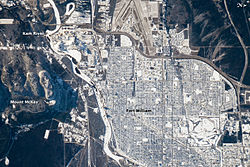 Fort William as seen from the International Space Station, December 2008
Fort William as seen from the International Space Station, December 2008
The city has an area of 328.48 square kilometres, which includes the former cities of Fort William and Port Arthur, as well as the townships of Neebing, Ontario and McIntyre. The former Fort William section occupies flat alluvial land along the Kaministiquia River. In the river delta are two large islands: Mission Island and McKellar Island.
The former Port Arthur section is more typical of the Canadian Shield, with gently sloping hills and very thin soil lying on top of bedrock with many bare outcrops. Thunder Bay, which gives the city its name, is about 22.5 kilometres (14.0 mi) from the Port Arthur downtown to Thunder Cape at the tip of the Sleeping Giant. The city reflects the settlement patterns of the 19th century and sprawls. Anchoring the west end of the city, the Fort William Town Plot surveyed in 1859–60 was named West Fort William (Westfort) in 1888 by the CPR. The land adjoining the lower Kaministiquia River became the residential and central business district of the town and city of Fort William. A large uninhabited area adjoining the Neebing and McIntyre rivers, which became known as Intercity, separated Fort William from the residential and central business district of Port Arthur. At the extreme east of the city, a part of McIntyre Township was annexed to the town of Port Arthur in 1892, forming what later became known as the Current River area.
Since 1970, the central business districts of Fort William and Port Arthur have suffered a serious decline. Business and government relocated to new developments in the Intercity area. There has also been substantial residential growth in adjacent areas of the former Neebing and McIntyre townships.
Climate
Thunder Bay and the area experiences a humid continental climate (Köppen climate classification Dfb)[12] that is influenced by Lake Superior, with especially noticeable effects in the city's north end. This results in cooler summer temperatures and warmer winter temperatures for an area extending inland as far as 16 km. The average daily temperatures range from 17.6 °C in July to −14.8 °C in January. The average daily high in July is 24.2 °C and the average daily high in January is −8.6 °C. On January 10, 1982, the local temperature in Thunder Bay dropped to −36 °C, with a wind speed of 54 km/h for a wind chill temperature that dipped to −58 °C. As a result, it holds Ontario's record for coldest day with wind chill.[13]
The city is quite sunny, with an average of 2167.7 hours of bright sunshine each year, ranging from 283.4 hours in July to 88.8 hours in November, sunnier than any city in Canada located to the east of it.[7]
Climate data for Thunder Bay Month Jan Feb Mar Apr May Jun Jul Aug Sep Oct Nov Dec Year Record high °C (°F) 8.3
(46.9)12.2
(54.0)22.8
(73.0)28.3
(82.9)35.2
(95.4)35.6
(96.1)37.2
(99.0)40.3
(104.5)31.7
(89.1)28.3
(82.9)21.7
(71.1)12.2
(54.0)40.3
(104.5)Average high °C (°F) −8.6
(16.5)−5.6
(21.9)0.3
(32.5)9.0
(48.2)16.4
(61.5)20.6
(69.1)24.2
(75.6)23.1
(73.6)17.1
(62.8)10.4
(50.7)1.7
(35.1)−6.1
(21.0)8.5 Daily mean °C (°F) −14.8
(5.4)−12
(10)−5.5
(22.1)2.9
(37.2)9.5
(49.1)14
(57)17.6
(63.7)16.6
(61.9)11
(52)5
(41)−3
(27)−11.6
(11.1)2.5 Average low °C (°F) −21.1
(−6.0)−18.4
(−1.1)−11.2
(11.8)−3.3
(26.1)2.5
(36.5)7.3
(45.1)11.0
(51.8)10.1
(50.2)4.9
(40.8)−0.5
(31.1)−7.7
(18.1)−17
(1)−3.6 Record low °C (°F) −41.1
(−42.0)−40
(−40)−36.7
(−34.1)−22.2
(−8.0)−8.9
(16.0)−2.8
(27.0)0.0
(32.0)−1.1
(30.0)−8.3
(17.1)−13.3
(8.1)−30.6
(−23.1)−37.8
(−36.0)−41.1
(−42.0)Precipitation mm (inches) 31.3
(1.232)24.9
(0.98)41.6
(1.638)41.5
(1.634)66.5
(2.618)85.7
(3.374)89.0
(3.504)87.5
(3.445)88.0
(3.465)62.6
(2.465)55.6
(2.189)37.5
(1.476)711.7
(28.02)Rainfall mm (inches) 2.5
(0.098)2.8
(0.11)17.5
(0.689)29.5
(1.161)65.0
(2.559)85.7
(3.374)89.0
(3.504)87.5
(3.445)87.5
(3.445)57.0
(2.244)31.5
(1.24)3.6
(0.142)559
(22.01)Snowfall cm (inches) 41.2
(16.22)26.9
(10.59)26.8
(10.55)12.4
(4.88)1.7
(0.67)0
(0)0
(0)0
(0)0.5
(0.2)6.1
(2.4)27.8
(10.94)44.1
(17.36)187.5
(73.82)Avg. precipitation days 11.9 10.0 10.9 8.8 10.5 13.4 12.7 12.6 13.3 11.7 11.6 12.3 139.7 Avg. rainy days .57 .87 3.4 6.6 10.3 13.4 12.7 12.6 13.2 10.7 5.1 1.1 90.54 Avg. snowy days 12.6 10.3 9.4 3.9 .61 0 0 0 .13 2.3 9.1 13.1 61.44 Sunshine hours 114.4 133.5 159.1 219.0 265.0 264.1 283.4 258.3 162.9 127.7 88.8 91.7 2,168.0 Source: Environment Canada[7] Neighbourhoods
Thunder Bay is composed of two formerly separate cities, Port Arthur and Fort William. Both still retain much of their distinct civic identities, reinforced by the buffering effect of the Intercity area between them. Port Arthur and Fort William each has its own central business districts and suburban areas. Some of the more well-known neighbourhoods include: the Bay and Algoma area, which has a large northern European population centred around the Finnish Labour Temple and the Italian Cultural Centre; Simpson-Ogden and the East End, two of the oldest neighbourhoods in Fort William located north of Downtown Fort William; Intercity, a large business district located between Fort William and Port Arthur; Current River, the northernmost neighbourhood of Port Arthur; and Westfort, the oldest settlement in Thunder Bay. Within city limits are some small rural communities, such as Vickers Heights and North McIntyre, which were located in the former townships of Neebing and McIntyre, respectively.
Government and politics
See also: Thunder Bay City CouncilThe city is governed by a mayor and twelve councillors. The mayor and five of the councillors are elected at large by the whole city. Seven councillors are elected for the seven wards: Current River Ward, McIntyre Ward, McKellar Ward, Neebing Ward, Northwood Ward, Red River Ward, and Westfort Ward.[14]
Thunder Bay is represented in the Canadian Parliament by Bruce Hyer and John Rafferty, both members of the New Democratic Party, and in the Ontario Legislature by Ontario Liberal Party members Michael Gravelle and Bill Mauro.
City symbols
A large formation of mesas on the Sibley Peninsula in Lake Superior which resembles a reclining giant has become a symbol of the city. Sibley peninsula partially encloses the waters of Thunder Bay, and dominates the view of the lake from the northern section of the city (formerly Port Arthur). The Sleeping Giant also figures on the city's coat of arms and the city flag.
 The Coat of Arms of the City of Thunder Bay, which incorporates features from the coats of arms of Port Arthur and Fort William.
The Coat of Arms of the City of Thunder Bay, which incorporates features from the coats of arms of Port Arthur and Fort William.
The Coat of arms of Thunder Bay, Ontario is a combination of the coats of arms of both Port Arthur and Fort William, with a unifying symbol—the Sleeping Giant—at the base of the arms.[15]
- Corporate logo
The city logo depicts a stylized thunderbird, called Animikii, a statue of which is located on the city's Kaministiquia River Heritage Park. The slogan, Superior by Nature, is a double play on words reflecting the city's natural setting on Lake Superior.[15]
Thunder Bay's flag was created in 1972, when mayor Saul Laskin wanted to promote the city by having a distinctive flag. The city held a contest, which was won by Cliff Redden. The flag has a 1:2 ratio, and depicts a golden sky from the rising sun behind the Sleeping Giant, which sits in the blue waters of Lake Superior. The sun is represented by a red maple leaf, a symbol of Canada. Green and gold are Thunder Bay's city colours.[15]
Sister cities
Thunder Bay has five sister cities on three continents,[16] which are selected based on economic, cultural and political criteria.
 Seinäjoki, Finland since 1974
Seinäjoki, Finland since 1974 Little Canada, Minnesota since 1977
Little Canada, Minnesota since 1977 Duluth, Minnesota since 1980
Duluth, Minnesota since 1980 Keelung, Taiwan since 1988
Keelung, Taiwan since 1988 Gifu, Japan since 2007
Gifu, Japan since 2007
Economy
Labour force[17][18] Rate Thunder Bay Ontario Canada Employment 57.7% 60.8% 62.2% Unemployment 7.6% 8.9% 7.7% Participation 62.4% 66.8% 67.4% As of: February 2009 As the largest city in Northwestern Ontario, Thunder Bay is the region's commercial, administrative and medical centre. Many of the city's largest single employers are in the public sector. The City of Thunder Bay, the Thunder Bay Regional Health Sciences Centre, the Lakehead District School Board and the Government of Ontario each employ over 1,500 people.[19] Bowater Forest Products is the largest private employer, employing over 1500 people.[20] Other major employers in the forestry sector include AbitibiBowater and Buchanan Forest Products. Bombardier Transportation operates a plant in Thunder Bay which manufactures mass transit vehicles and equipment, employing approximately 800 people.[20]
Employment by industry, 2006[4] Industry Thunder Bay Ontario Agriculture and resource-based 3.6% 2.9% Construction 5.4% 5.9% Manufacturing 7.7% 13.9% Wholesale Trade 2.8% 4.7% Retail trade 12.7% 11.1% Finance and real estate 4.2% 6.8% Health care and social services 15.2% 9.4% Education services 8.9% 6.7% Business services 16.8% 19.7% Other services 22.6% 18.7% The rising cost of electricity in Ontario has threatened the viability of primary industries in the region, resulting in the laying off of workers at pulp and saw mills. The grain trade has declined because of the loss of grain transportation subsidies and the loss of European markets. The gradual transition from shipping by train and boat to shipping by truck, and the Canada-United States Free Trade Agreement have ended Thunder Bay's privileged position as a linchpin in Canadian east-west freight-handling trade. As a result the city has lost its traditional raison d'être as a break-bulk point.[4] However, in recent years shipments through the port of Thunder Bay have stabilized, and remains an important part of the Saint Lawrence Seaway.[21]
In an effort to rejuvenate its economy, the city has been actively working to attract quaternary or "knowledge-based" industries, primarily in the fields of molecular medicine and genomics.[22][23] The city is home to the western campus of the Northern Ontario School of Medicine, the first medical school to open in Canada in a generation.[24]
Infrastructure
Transportation
Main article: Transportation in Thunder Bay, OntarioThunder Bay receives air, rail and shipping traffic due to its prime location along major continental transportation routes. Greyhound Canada provides coach service to both regional and national destinations, with the municipally owned Thunder Bay Transit providing 17 routes across the city's urban area. The city is served by the Thunder Bay International Airport, the fourth busiest airport in Ontario by aircraft movements.[25] The main highway through the city is Highway 11/17, a four lane highway designated as the Thunder Bay Expressway.
The city is an important railway hub, served by both the Canadian National and Canadian Pacific Railway. Passenger rail service to Thunder Bay ended on 15 January 1990, with the cancellation of Via Rail's southern transcontinental service.[26]
- Harbour
Thunder Bay has been a port since the days of the North West Company which maintained a schooner on Lake Superior. The Port of Thunder Bay is the largest outbound port on the St. Lawrence Seaway System,[27] and the sixth largest port in Canada.[24] The Thunder Bay Port Authority manages Keefer Terminal, built on a 320,000 square metre site on Lake Superior.
Medical centres and hospitals
Thunder Bay has one major hospital, the Thunder Bay Regional Health Sciences Centre. Other health care services include the St. Joseph's Care Group, which operates long term care centres such as the Lakehead Psychiatric Hospital, St. Joseph's Hospital, and Hogarth Riverview Manor. The Northern Ontario School of Medicine has a campus at Lakehead University. The city is also home to a variety of smaller medical and dental clinics.
Population and demographics
Selected Ethnic
Origins, 2006[28]Ethnic origin Population English 34,360 Scottish 26,400 Canadian 24,650 Irish 22,260 French 21,165 Ukrainian 17,620 Italian 17,290 Finnish 14,510 German 13,090 Aboriginal 11,870 Polish 8,595 Swedish 5,580 Visible minorities 3,175 multiple responses included City of Thunder Bay Population by year[29] 1911 27,719 1921 35,427 1931 46,095 1941 55,011 1951 66,108 1956 77,600 1961 92,490 1966 104,539 1971 108,411 1976 111,476 1981 112,486 1986 112,272 1991 113,946 1996 113,662 2001 109,016 2006 109,140 According to the 2006 Census, there were 109,140 people residing in Thunder Bay on 16 May 2006, of whom 48.4% were male and 51.6% were female. Residents 19 years of age or younger accounted for approximately 22.9% of the population. People aged by 20 and 39 years accounted for 24.6%, while those between 40 and 64 made up 35.9% of the population. The average age of a Thunder Bayer in May 2006 was 41.7, compared to the average of 39.5 for Canada as a whole.[4]
Between the censuses of 2001 and 2006, Thunder Bay's population increased by 0.1%, compared to the average of 6.6% for Ontario and 5.4% for Canada. The population density of the city of Thunder Bay averaged 332.3 people per square kilometre, compared with an average of 13.4 for Ontario. The total population has been stagnant or declining since amalgamation in 1970.
A further 13,767 people live in Thunder Bay's Census Metropolitan Area, which apart from Thunder Bay includes the municipalities of Neebing and Oliver Paipoonge, the townships of Conmee, Gillies, O'Connor and Shuniah, and the aboriginal community of Fort William First Nation.[30]
- Ethnicity
Thunder Bay is home to 12,825 people of Finnish descent,[31] the highest concentration of persons of Finnish origin per capita in Canada, and the second largest Finnish population in Canada after Toronto which has 14,750 persons of Finnish origin.
- Language
In terms of Canada's official languages, 81.6% of Thunder Bayers speak only English, and 2.6% speak only French. Thunder Bay has one of the largest established communities of Finnish speaking people outside of Finland.[32] Other languages spoken in Thunder Bay include Italian and Ojibwe.
- Religion
The 2001 census states that 82.0 per cent of Thunder Bay residents belong to a Christian denomination, 39.8% of which are Roman Catholic, 39.5% Protestant, and 2.6% other following Christian denominations, mostly Eastern Orthodox. Those who follow other religions make up less than 1% of the population, while the remaining 17.0% are non-religious.
Visitor attractions
Thunder Bay's main tourist attraction is Fort William Historical Park, a reconstruction of the North West Company's Fort William fur trade post as it was in 1815, which attracts 100,000 visitors annually.[33] The marina in downtown Port Arthur, an area known as The Heart of the Harbour, draws visitors for its panoramic view of the Sleeping Giant and the presence of various water craft. The marina also includes a lake walk, playground, harbour cruises, a children's museum, and a Chinese/Canadian restaurant. There are several small surface amethyst mines in the area, some of which allow visitors to search for their own crystals.[34] A 2.74 m (9 ft) statue of Terry Fox is situated at the Terry Fox Memorial and Lookout on the outskirts of the city near the place where he was forced to abandon his run. Other tourists attractions are listed below.
- Bluffs Scenic Lookout
- Boulevard Lake Park
- Canada Games Complex
- Canadian Lakehead Exhibition
- Cascades Conservation Area
- Centennial Conservatory
- Centennial Park
- Chapples Park
- Chippewa Park
- Connaught Square
- Finnish Labour Temple
- Fort William Gardens
- Fort William Stadium
- Hillcrest Park
- The Hoito
- Intercity Shopping Centre
- Kakabeka Falls
- Magnus Theatre
- Mount McKay Lookout
- Northwestern Ontario Sports Hall of Fame
- Ouimet Canyon
- Port Arthur Stadium
- Silver Falls
- Thunder Bay Art Gallery
- Thunder Bay Community Auditorium
- Thunder Bay Historical Museum
- Thunder Bay Marina
- Thunder Bay Restaurant
- International Friendship Gardens
- Trowbridge Falls
- Victoriaville
- Waverley Park
- Whitewater Golf Club
Education
Main article: Education in Thunder Bay, OntarioThunder Bay has 38 elementary schools, 3 middle schools, 8 secondary schools, 2 private schools, and an adult education facility. The city also has several other private for-profit colleges and tutoring programmes. Post secondary institutions in Thunder Bay include Confederation College and Lakehead University.
The Lakehead District School Board is the largest school board in the city, with 22 elementary schools, 4 secondary schools and a centre for adult studies. The Thunder Bay Catholic District School Board is the second largest with 16 elementary schools, 3 middle schools and 2 high schools. Conseil scolaire de district catholique des Aurores boréales operates one elementary and one high school in Thunder Bay, and an additional six schools throughout the Thunder Bay District.
Culture
The city of Thunder Bay was declared a "Cultural Capital of Canada" in 2003.[35] Throughout the city are cultural centres representing the diverse population, such as the Finnish Labour Temple, Scandinavia House, the Italian Cultural Centre, the Polish Legion, and a wide variety of others. Shags, a combination shower and stag held to celebrate the engagement of a couple,[36] and Persians, a cinnamon bun pastry with pink icing, originated in the city.[37][38] Thunder Bay is served by the Thunder Bay Public Library, which has four branches.
The arts
Thunder Bay is home to a variety of music and performance arts venues. The largest professional theatre is Magnus Theatre. Founded in 1971, it offers six stage plays each season and is located in the renovated Port Arthur Public School on Red River Road. The Thunder Bay Community Auditorium, which seats 1500, is the primary venue for various types of entertainment. It is the home of the Thunder Bay Symphony Orchestra, which has 30 full-time and up to 20 extra musicians presenting a full range of classical music.[39] New Music North is vital to the contemporary classical music scene in the city by offering intriguing and novel contemporary chamber music concerts.[40]
The Bay Street Film Festival, established in 2005, is an independent film festival that features local, national, and international films with the theme of "Films for the People." The festival is held in early October at 314 Bay Street in the historic Finnish Labour Temple.[41] Thunder Bay is also home to the North of Superior Film Association (NOSFA). Established in 1992, the NOSFA features monthly screenings of international and Canadian films at the Cumberland Cinema Centre, with a spring film festival that attracts several thousand patrons.[42]
Museums and galleries
The Thunder Bay Art Gallery which was founded in 1976, specializes in the works of First Nations artists, having a collection of national significance. The Thunder Bay Historical Museum Society, founded in 1908, presents local and travelling exhibitions and houses an impressive collection of artifacts, photographs, paintings, documents and maps in its archives.
Thunder Bay has two recognized Federal Heritage buildings on the Register of the Government of Canada Heritage Buildings: [43]
- Ordnance Store Recognized - 1997
- Park Street Armoury Recognized - 1994
both are part of HMCS Griffin.
Places of worship
Thunder Bay has many places of worship supported by people of a variety of faiths, reflecting the cultural diversity of the population.[44] A sample:
- Assumption of the Blessed Virgin Mary Church - Ukrainian Orthodox (716 Pacific Avenue). The original wooden church, built by Ukrainian Orthodox families in 1911/1912 was almost destroyed by fire in 1936. The current church was built on the same site, opening in 1937. It has decorative gold domes that are characteristic of Ukrainian churches of the Bukovina area, with Orthodox crosses atop the domes.[45]
- Calvary Lutheran Church (Donald and Edward St) was established in 1958 as a mission congregation of the Minnesota North District. website
- Church of Jesus Christ of Latter-day Saints (2255 Ponderosa Dr). The church has a family history library open to anyone to research their genealogy.
- Elim Community Christian Centre (360 Black Bay Rd). Pentecostal Church located in Current River area of the city. website
- Evangel Church (1260 Balmoral St). Contemporary Pentecostal church with a strong emphasis on children, youth and (with their convenient location next to Lakehead University) young adults. website
- Hilldale Lutheran Church (321 Hilldale Rd). Offers services in both English and Finnish. website. The church has an intimate atmosphere and wonderful acoustics, and is frequently used for musical performances.[46]
- Holy Trinity Greek Orthodox Church (651 Beverly St). Founded in 1918, the church moved to its present building in 1991. The church is active in providing non-profit housing for needy families. website
- Hope Christian Reformed Church (1315 Crawford Ave). Services are recorded so that anyone with an internet connection may listen. website
- Kitchitwa Kateri Anamewgamik (451 Syndicate Ave N). Roman Catholic communal church geared to Native culture and teachings. A drop-in centre provides coffee and serves soup & bannock.
- Lakehead Unitarian Fellowship (129 S. Algoma St ). This Unitarian Universalist community includes Christians, Post-Christians, Buddhists, Pagans, Theists, Non-theists, Humanist-agnostics, and Atheists. They welcome and celebrate the presence and participation of gay, lesbian, bisexual, and transgendered persons. website
- Saalem Church (21 Walkover St). Offers services in both English and Finnish. website
- Shaarey Shomayim Congregation - Jewish Synagogue (627 Grey Street). This egalitarian community has the only mikvah between Winnipeg and Toronto.
- Shepherd of Israel Congregation - Messianic Jewish (534 McLaughlin St). Affiliated with Evangelical movement.
- St Agnes Church. Roman Catholic Church (1019 Brown St). Founded in 1885, the new St. Agnes Church and Hall was dedicated on June 6, 1982. St. Vincent de Paul Society operates a food bank out of this church. website
- St Stephen the Martyr Anglican Church (494 Leslie Ave). Provides a food cupboard for the Current River area. website
- St. John the Evangelist Anglican Church (226 Pearl St). Founded in 1872, the current building was erected in 1884. website
- St. Patrick's Cathedral - Roman Catholic (211 Archibald St S). The old St. Patrick's Church was built in 1893. In 1963 it was replaced by the current cathedral on the same site. website
Sports and recreation
Thunder Bay's proximity to the wilderness of the Boreal Forest and the rolling hills and mountains of the Canadian Shield allow its residents to enjoy very active lifestyles. The city has hosted several large sporting events including the Summer Canada Games in 1981, the Nordic World Ski Championships in 1995, the Continental Cup of Curling in 2003, and the World Junior Baseball Championship in 2010.
Recreational facilities
Thunder Bay enjoys many recreational facilities. The city operates fifteen neighbourhood community centres, which offer various sporting and fitness facilities as well as seasonal activities such as dances. The city also operates six indoor ice rinks and 84 seasonal outdoor rinks,[47] two indoor community pools and three seasonal outdoor pools as well as a portable pool and two maintained public beaches, several curling sheets, and three golf courses, among others.[48] Listed below are some of the city's major facilities.
Multi-use facilities
- The Canada Games Complex
- The Fort William Gardens
- Port Arthur Stadium
- Royal Canadian Legion Sports Complex
- Thunder Bay Sports Dome[49]
Municipal ice rinks and indoor pools
- Current River Arena
- Delaney Arena
- Grandview Arena
- Neebing Arena
- Port Arthur Arena
- Thunder Bay Tournament Centre (2 ice surfaces)
- Sir Winston Churchill Community Pool
- Volunteer Community Pool
Golf courses[50]
- Centennial Golf Course (9 holes)
- Chapples Memorial Golf Course (18 Holes)(Municipal)
- Dragon Hills Golf Course (9 holes)
- Emerald Greens Golf Course (9 holes)
- Fort William Country Club (18 Holes)
- Municipal Golf Course (9 holes)(Municipal)
- Northern Lights Golf Complex (9 holes par 3/9 holes regulation)
- Strathcona Golf Course (18 holes)(Municipal)
- Thunder Bay Country Club (9 holes)
- Whitewater Golf Club (18 holes)
Ski hills
- Loch Lomond Ski Resort
- Mount Baldy Ski Resort
Cross-Country Skiing Facilities
- Lappe Nordic Ski Centre
- Kamview Nordic Centre
Sports teams
Club Sport League Venue Thunder Bay North Stars Ice Hockey Superior International Junior Hockey League Fort William Gardens Lakehead Thunderwolves Basketball Ontario University Athletics C.J. Sanders Fieldhouse Lakehead Thunderwolves Ice Hockey Ontario University Athletics Fort William Gardens Lakehead Thunderwolves Volleyball Ontario University Athletics C.J. Sanders Fieldhouse Thunder Bay Border Cats Baseball Northwoods League Port Arthur Stadium Thunder Bay Chill Soccer USL Premier Development League Chapples Park Stadium Thunder Bay is also home to the National Development Centre - Thunder Bay, an elite cross-country ski team that attracts many of Canada's best Junior and U-23 skiers.
Sport events
Thunder Bay 10 Mile Road Race
Media
Main article: Media in Thunder BayPrint
Thunder Bay has one daily newspaper, The Chronicle-Journal, which has a circulation of approximately 28,000 and has coverage of all of Northwestern Ontario.[51] There are two weekly news papers—Thunder Bay's Source, a weekly newspaper operated by Dougall Media, and Canadan Sanomat, a Finnish language weekly newspaper. Lakehead University has a student newspaper called The Argus, which is published weekly during the school year.[52] The Chronicle Journal publishes a free weekly called Spot every Thursday, focusing on entertainment. The city publishes a bi-monthly newsletter to citizens titled yourCity, which is also available online in a PDF format, by electronic subscription and RSS feed.[53] Netnewsledger is a daily updated website covering news and current events in Thunder Bay, which places emphasis on connecting politicians to their constituents.[54]
Television
Three English language stations and one French language station supply Thunder Bay with free over-the-air television. Programming from the Global and CBC networks is provided by a locally owned twinstick operation branded as Thunder Bay Television, and the city receives TVOntario on channel 9 and the French CBLFT on channel 12. CTV is now cable-/satellite-only in the area.
The cable provider in Thunder Bay is Shaw, although locally owned TBayTel, has been granted a license by the Canadian Radio-television and Telecommunications Commission (CRTC) to compete in the cable TV market.[55] The community channel on Shaw Cable is branded as Shaw TV, and airs on cable channel 10.
WBKP TV channel 5, the CW / ABC affiliate in Calumet, Michigan can be received in Thunder Bay with an outdoor roof antenna and a digital-capable television or receiver.
Radio
Thunder Bay is home to 11 radio stations, all of which broadcast on the FM band.
There are four commercial radio stations based in the city — Rock 94.3 and CKPR 91.5, owned by Dougall Media, the parent company of Thunder Bay Television and Thunder Bay's Source, and Magic 99.9 and 105.3 The Giant, owned by Acadia Broadcasting. One additional station, Thunder 103.5, targets the Thunder Bay market from transmitters in Kaministiquia and Shuniah. The city receives CBC Radio One as CBQT-FM and CBC Radio 2 as CBQ-FM, at 88.3 FM and 101.7 FM respectively. The French Première Chaîne is available as a repeater of Sudbury-based CBON-FM on 89.3 FM. Lakehead University operates a campus radio station, CILU-FM, at 102.7 FM, and CJOA-FM 95.1 broadcasts Christian-oriented programming and is run by a local non-profit group.
Short List of Notable Residents
Main article: List of people from Thunder Bay, OntarioPaul Shaffer, bandleader on the American Late Show with David Letterman,[56] and recipient of the Order of Canada.
Bobby Curtola, an early rock and roll singer and one-time teen idol.[57]
Norval Morriseau, artist.
Lauri Conger, keyboardist and songwriter, and a member of the Canadian band Parachute Club.
Gary Kendall, musician, solo artist and multiple Maple Blues Award winner.
Kevin Durand, actor.
Current NHL players: Patrick Sharp, Ryan Johnson, Alex Auld, Tom Pyatt, Taylor Pyatt, Jared Staal, Eric Staal, Marc Staal, Jordan Staal.
Former NHL players: Alex Delvecchio, Greg Johnson, Trevor Letowski.[58]
Katie Weatherston, Olympic gold medalist.
Haley Irwin, Olympic gold medalist.
Jay Miron, professional BMX rider and 9-time X-Games medalist.[59]
Clarence Decatur Howe, originally from Massachusetts, moved to Canada in his early adult years and, as "Minister of Everything" played a major role in the economic development of Canada.[60]
Saul Laskin, city's first mayor.
Bora Laskin, Chief Justice of the Supreme Court of Canada from 1973 to 1984.[61]
Elizabeth Lawrie Smellie was a nurse, and the first woman to be promoted to the rank of colonel in the Canadian army.[62]
Notes and references
- Thorold J. Tronrud and A. Ernest Epp (1995) Thunder Bay: From Rivalry to Unity, Thunder Bay Historical Museum Society, ISBN 0-920119-20-4
- ^ City Hall, Thunder Bay City Council. Retrieved on 2 June 2007.
- ^ Municipal Code, by-law 218-2003. Retrieved on 2 June 2007.
- ^ Burkowski, Peter. "City appoints new city manager," The Chronicle-Journal (19 August 2008). Retrieved 19 August 2008.
- ^ a b c d e City of Thunder Bay, 2006 Community Profile. Statistics Canada. Retrieved on 27 April 2011.
- ^ a b Thunder Bay CMA, 2006 Community Profile. Statistics Canada. Retrieved on 27 April 2011.
- ^ The Port of Thunder Bay, The Transportation Sector. City of Thunder Bay. Retrieved on 30 November 2007.
- ^ a b c "Canadian Climate Normals 1971-2000". Thunder Bay A, Ontario: Environment Canada. http://climate.weatheroffice.gc.ca/climate_normals/results_e.html?Province=ALL&StationName=thunder%20bay&SearchType=BeginsWith&LocateBy=Province&Proximity=25&ProximityFrom=City&StationNumber=&IDType=MSC&CityName=&ParkName=&LatitudeDegrees=&LatitudeMinutes=&LongitudeDegrees=&LongitudeMinutes=&NormalsClass=A&SelNormals=&StnId=4055&. Retrieved 2011-04-27.
- ^ a b c Brief History of Thunder Bay, City of Thunder Bay. Retrieved on 5 June 2007.
- ^ Tronrud, Thorold J; Epp, Ernest A.; and others. (1995). "Introduction", Thunder Bay: From Rivalry to Unity, p. vii, Thunder Bay Historical Museum Society ISBN 0-920119-22-0
- ^ F.B. Scollie, "Falling into Line : How Prince Arthur's Landing Became Port Arthur," Thunder Bay Historical Museum Society Papers and Records, XIII (1985) 8-19.
- ^ About Thunder Bay, pp. 2. Retrieved on 2 September 2007.
- ^ http://people.eng.unimelb.edu.au/mpeel/Koppen/World_Koppen_Map.png
- ^ Ontario Region Winter Weather Factsheet, Environment Canada. Retrieved on 11 April 2008
- ^ Guide to City Services, Municipal Government, Wards. Retrieved on 4 June 2007
- ^ a b c Thunder Bay City Symbols. Retrieved on 4 June 2007.
- ^ Thunder Bay Sister Cities. Retrieved on 11 August 2007
- ^ Labour Force Characteristics, Seasonally adjusted, by CMA. Statistics Canada. Retrieved on 13 March 2009.
- ^ Labour Force Survey. Statistics Canada. Retrieved on 13 March 2009.
- ^ Major Employer List - Thunder Bay, 2006 45kb. Retrieved on 2 September 2007.
- ^ a b Thunder Bay Top Private Sector Employers, Northern Ontario Business (May 2006). Retrieved on 4 September 2007.
- ^ 56-Year Cargo Statistics, Port of Thunder Bay. Retrieved on 20 December 2009.
- ^ New Molecular Medicine Research Centre to be Headquartered in Thunder Bay, TBRHSC.com (6 September 2006). Retrieved on 4 September 2007
- ^ Genesis Genomics. Retrieved on 2 September 2007.
- ^ a b Thunder Bay Blends Old, New Industries, Site Selection (November 2005). Retrieved on 4 September 2007
- ^ TP 1496 Preliminary aircraft statistics 2006. Transport Canada. Retrieved on 2 September 2007.
- ^ Canada Transportation Act, 1990. Order Varying Certain National Transportation Agency Orders Respecting Railway Companies, SOR/89-488 S III 1. (2) (c). Retrieved on 5 June 2007
- ^ Port of Thunder Bay, official website. Retrieved on 2 September 2007.
- ^ Profile of Ethnic Origin and Visible Minorities for Census Metropolitan Areas and Census Agglomerations, 2006 Census. Statistics Canada. Retrieved on March 13, 2009.
- ^ The People of Thunder Bay. Retrieved 1 September 2007.
For 1911: Tronrud, Thorold J; Epp, Ernest A.; and others. (1995). Thunder Bay: From Rivalry to Unity. Thunder Bay Historical Museum Society, pp. 59. ISBN 0-920119-22-0. - ^ 2006 Census Population Counts by Municipality, Thunder Bay CMA. Statistics Canada. Retrieved on 2 September 2007.
- ^ Finnish population in Canada. Retrieved 2 September 2007.
- ^ Thunder Bay Public Library - Community - Finnish Community. Retrieved 28 June 2008.
- ^ Fort William Historical Park, Planning Your Visit - Beginnings. Retrieved on 4 June 2007
- ^ Ontario Amethyst: Mining Ontario’s Amethyst Ontario Ministry of Northern Development and Mines. Retrieved on 4 August 2007.
- ^ Cultural Capitals of Canada 2003. Retrieved on 4 June 2007.
- ^ Seven Wonders of Thunder Bay, Shags. Thunder Bay Source. Retrieved on 11 June 2007.
- ^ Thunder Bay Food. Retrieved on 11 June 2007.
- ^ The Universal Cynic (26 June 2006) Lexicon of Yore. Retrieved on 11 June 2007.
- ^ Thunder Bay Symphony Orchestra. Retrieved on 2 September 2007.
- ^ New Music North. Retrieved 2 August 2008.
- ^ Bay Street Film Festival. Retrieved on 2 September 2007.
- ^ NOSFA Website. Retrieved on 2 September 2007.
- ^ http://www.pc.gc.ca/apps/beefp-fhbro/FHB_Rech_Search_e.asp Register of the Government of Canada Heritage Buildings.
- ^ "Thunder Bay Community Information Database: Churches" Thunder Bay Community Information & Referral Center. Retrieved 3 Jan 2009
- ^ Ukrainian Orthodox Church of the Assumption of the Blessed Virgin Mary City of Thunder Bay. Retrieved 3 Jan 2009
- ^ "Thunder Bay Symphony Orchestra Brochure" TBSO. Retrieved 3 Jan 2009
- ^ City of Thunder Bay - Outdoor Rinks. Retrieved on January 2008
- ^ Thunder Bay Telephone (2007) TBayTel 2007–2008 Directory, Pages 56 to 58.
- ^ The Sports Dome. Retrieved 24 January 2008.
- ^ Golf Thunder Bay and Golflink - Thunder Bay[dead link], Retrieved on 2 September 2007.
- ^ Sudbury Star and Sault Star Part of Media Buyout. Netnewsledger, 1 June 2007. Retrieved on 8 June 2007.
- ^ The Argus. Retrieved on 8 June 2007
- ^ Your City, Thunder Bay. Retrieved on 2 September 2007.
- ^ Netnewsledger home page. Retrieved 20 January 2008.
- ^ CRTC Decision 2008-289 - CRTC. Retrieved on March 3, 2009
- ^ Paul Shaffer Bio at CBS - Late Show. Retrieved on 20 April 2007.
- ^ Curtola's Official Website. Retrieved on 20 April 2007.
- ^ Eric Staal at The Internet Hockey Database. Retrieved 20 April 2007.
- ^ Printable Biography of Jay Miron, All-American Talent and Celebrity Network. Retrieved on 2 October 2007.
- ^ Federal Experience. Parlinfo Parliamentarian file. Retrieved 20 April 2007.
- ^ Official Biography[dead link], Supreme Court of Canada website. Retrieved on 20 April 2007.
- ^ MacLean, Mary R. Colonel Elizabeth Smellie CBE, Thunder Bay Historical Museum Society, Papers and Records, III (1975), 16–18 with reproduction of portrait by Kenneth Forbes on page 16.
External links
- City of Thunder Bay Official Website
- City of Thunder Bay Official Tourism Website
- Thunder Bay Chamber of Commerce
- Thunder Bay International Airports Authority

Unorg. Thunder Bay District (Lappe) Shuniah 
Oliver Paipoonge 
Thunder Bay (Lake Superior)  Thunder Bay
Thunder Bay 

Neebing, Fort William 52 Cities Thunder Bay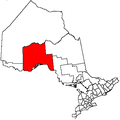
Towns Townships First Nations Aroland • Biinjitiwabik Zaaging Anishnabek (Rocky Bay) • Bingwi Neyaashi Anishinaabek (Sand Point) • Fort William • Ginoogaming • Kiashke Zaaging Anishinaabek (Gull Bay) • Lac Des Mille Lacs • Long Lake 58 • Namaygoosisagagun • Saugeen (Savant Lake) • Pays Plat • Pic River • Pic Mobert • Red Rock (Lake Helen) • Seine River • WhitesandIndian Reserves Unorganized areas Unorganized Thunder Bay (Local services boards: Armstrong • Hurkett • Kaministiquia • Lappe • Rossport • Shebandowan)Ghost towns See also: Communities in Thunder Bay District • Census divisions of OntarioCensus metropolitan areas (CMAs) in Canada by size Toronto, ON · Montreal, QC · Vancouver, BC · Ottawa, ON · Calgary, AB · Edmonton, AB · Quebec City, QC · Winnipeg, MB · Hamilton, ON · London, ON · Cambridge-Kitchener-Waterloo, ON · St. Catharines-Niagara, ON · Halifax, NS · Oshawa, ON · Victoria, BC · Windsor, ON · Saskatoon, SK · Regina, SK · Sherbrooke, QC · St. John's, NL · Barrie, ON · Kelowna, BC · Abbotsford, BC · Greater Sudbury, ON · Kingston, ON · Saguenay, QC · Trois-Rivières, QC · Guelph, ON · Moncton, NB · Brantford, ON · Thunder Bay, ON · Saint John, NB · Peterborough, ON
Categories:- Populated places on the Great Lakes
- Port settlements in Ontario
- Populated places established in 1679
- Thunder Bay
Wikimedia Foundation. 2010.


